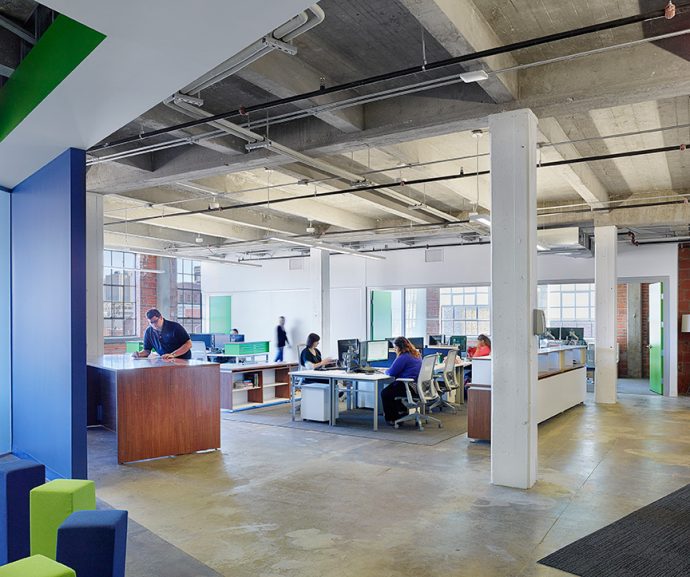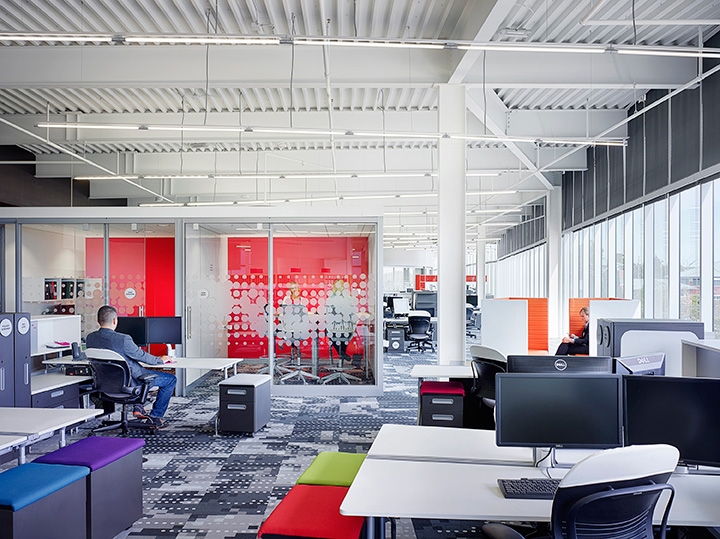Kay Sargent on creating a curated workplace experience, where everyone has the opportunity to be happy, healthy, empowered, and engaged.

People are the chief currency and greatest asset of any business. With up to 80 percent of a company’s expenses coming from human resources, it’s vital that their workforce is productive, engaged, and empowered. Unfortunately, 68 percent of U.S. workers are disengaged, according to the latest edition of Gallup’s annual engagement survey. Though there are many factors contributing to this alarming statistic, attitude plays a major role in workplace engagement. And although a well-designed space will have a positive impact on the occupants, we cannot discount or downplay the impact of individual attitudes. In this article, Kay Sargent, senior vice president and director of HOK’s Strategic Accounts practice, looks at how we can create a curated experience, where everyone has the opportunity to be happy, healthy, empowered, and engaged.
Why does attitude play such a major role? Because people influence people. Entrepreneur John Rohn noted that “we are the average of the five people we spend the most time with.” Longevity researcher Dan Buettner and his Blue Zones team have identified nine specific characteristics of places where people live longer. On that list is choosing the right tribe, which means surrounding yourself with people who support positive behaviors.
Of course, the converse is also true. If you are surrounded by negativity, it’s likely to spread. “CAVE dwellers,” those who are “consistently against virtually everything,” do exist.
It stands to reason that the people we sit near influence the way we feel about our workplace. Research shows that individuals are more loyal to the people they work with than the company they work for. A recent Harvard Business Review study noted the significant role that friendships have on our level of satisfaction and engagement at work. It revealed that, ” …camaraderie promotes a group loyalty that results in a shared commitment to and discipline toward the work. Camaraderie at work can create ‘esprit de corps,’ which includes mutual respect, sense of identity, and admiration to push for hard work and outcomes.”
A separate study by the Harvard Business School, in collaboration with Cornerstone OnDemand, showed the open office is likely not going away anytime soon, despite the growing number of people who show disdain for it. The study showed that in densified spaces populated with productive people, the productivity and effectiveness of nearby workers increased. But for those who sat near toxic workers, there was a “spillover effect”. This sphere of influence diminishes outside a 25-foot radius. Given that the average per-person space allocation in the modern workplace is 150 square feet, one bad egg — or disengaged worker — can negatively influence up to 16 people without even moving from his or her desk.

A bad attitude is contagious and a good one is infectious. This means the effectiveness of open plans or activity-based work (ABW) spaces may depend on how they are used and who is occupying them, in addition to how they are designed.
The stakes are particularly high for the 51 percent of workers who fall in the “not engaged” category in Gallup’s most recent engagement survey. Whether these individuals remain in the middle of the engagement pack, improve, or become even less engaged will be heavily influenced by the people who surround them.
Experiments within various workspaces have revealed that once employees are assigned a space, they tend to lay down roots. This reduces their mobility within the office while making them even more vulnerable to “toxic workers”.
In Europe and Australia, where ABW is common, work points in those environments are unassigned and employees are free to move around to various spaces to match their work setting to a variety of work styles. Because they’re not assigned a permanent spot, they can self-select their neighbors.
No one voluntarily sits next to a whiner — except perhaps another whiner. Positive people want to be near those with similar attitudes and energy. This organic selection process diminishes the ability for negative, toxic employees to rub off on those who choose not to be in that setting, whereas assigned workers with little to no choice are impacted daily.
Generational considerations
We have long known that one challenge in transitioning to a more open, collaborative environment is addressing the sense of entitlement that many workers have. The more entitled or entrenched people are, the more extensive the change management program needs to be.
A recent Leesman survey showed fewer differences between millennials and baby boomers than many originally thought. But one of the differences between generations is their attitude. Baby boomers tend to have more of a sense of entitlement (“I’ve earned it”), while millennials have a sense of desire (“I want it”). One is based on past performance and the other is focused on the future.
A bad attitude is contagious and a good one is infectious. This means the effectiveness of open plans or activity-based work (ABW) spaces may depend on how they are used and who is occupying them, in addition to how they are designed.
With the emergence of Generation Z (individuals born since 2000), we will soon have a new group of worker attitudes to consider. We need to prepare for the arrival of this “always-on” generation of digital natives. The pressure to be available 24 hours a day is creating anxiety, emotional detachment, and other health issues that may make this the least healthy generation yet. The World Health Organization predicts that “techno-stress” — the feeling that you need to be connected 24/7 — will be the next decade’s health epidemic. It’s estimated that 61.8 percent of female and 77.9 percent of male Gen Zs will be obese by the time they reach adulthood due to lack of physical activity.
To help Generation Z workers be productive and focused, designers need to provide a variety of work zones tailored to different kinds of tasks and create team-based environments that support community and a sense of belonging. These spaces should minimize visual clutter, simplify navigation, intensify contrast, and provide plenty of light. We also must recognize that fitness is not a destination, but a way of life. How we design space and embed movement is vital to supporting people in a world that continues to promote excessive ease.
No workplace can single-handedly solve an HR issue or cure employees with a bad attitude. But we can offer people options, embed healthier alternatives, and provide them with choices so that they’re not forced to sit next to a toxic person all day.

Addressing concerns about unassigned seating
Critics of unassigned seating commonly cite two concerns: the erosion of corporate culture and the fact that people are creatures of habit and tend to squat anyway. The development of neighborhood-based plans helps create a sense of community that sustains corporate culture. True collaboration happens when people connect. When they connect, they bond. When they bond, they trust. When they trust, they open up. And that’s when collaboration and innovation happens. Today’s “free-range” or “team-based choice environments” enable people to connect while providing them with a sense of belonging and identity.
We also need to design space that gives people opportunities to connect with each other in smaller, more intimate settings. Studies show that individuals can form tight bonds in groups of four to six people. By creating smaller, tightly connected groupings, we empower a “camp” mentality that facilitates community. These camp areas can be grouped in clusters that form a “clan” of up to 24, which feeds into a larger neighborhood — or “tribe” — of 48.
Critics of unassigned seating also say that we are creatures of habit and tend to sit in the same spot every day. That is often true, but sitting in the same spot every day is one of the choices you have, as long as you’re not so tied to it you “own” it and squat. And as long as your preference to sit in the same spot does not prohibit others from selecting different settings, then the needs and preferences of all can be met.
Happy, healthy, engaged, and empowered people work harder for you any day than unhappy, unhealthy, and disengaged people. We all intuitively know that, but we’re so focused on trying to find the key to productivity that we can miss the obvious. We need to ensure that our best asset, and the true currency of business — people, —are happy, healthy, engaged, and empowered. If we focus more on the those factors and the power of positive attitude, and the impact that it has on us in any space, then we can start creating the types of environments that we want to experience.
Frank Ocean once noted, “Don’t confuse my personality with my attitude. My personality is who I am. My attitude depends on who you are.”
As workplace strategists, designers, and real estate professionals, we can design and even control the spaces we create. But we cannot control the attitudes of those who occupy them. Though a well-designed space will have a positive impact on the occupants, we cannot discount or downplay the impact of individual attitudes.
Change management goes a long way to reinforce a positive fit between the people and the space. Frank Duffy once noted that, “As facility managers, we prepare space for people. As change managers, we prepare people for space.” Our approach should focus on creating a curated experience, where everyone has the opportunity to be happy, healthy, empowered, and engaged. And has the opportunity to sit where, and by whom, they best match to.

Case in point
Leaders at Valorem Consulting, a Kansas City-based technology company (pictured throughout), envisioned their renovated headquarters building as a progressive space that could quickly grow and change to support their continuously changing business needs. Given the culture and fast-paced work environment, unassigned seating was a natural choice. The 14,500 square foot office has more than 150 employees who have embraced a flexible work environment.
On any given day, you’ll find staff informally meeting and working at traditional workstations or large bar-height tables as well as on lounge seating and in two-person enclaves. On-site amenities including pool and ping-pong tables, treadmill desks, and a kitchen stocked with healthy snacks promote relaxation, activity, and engagement.
By moving away from assigned workstations and incorporating these employee-centric amenities, Valorem’s space has become synonymous with its values, as well as with thriving employees who have been given the freedom to tailor their work environments to maximize their satisfaction and productivity.
[/cointent_lockedcontent]



Yes you have said very true that workplace attitude is the most important thing which can result in productivity. We all need to be productive, engaged and empowered. There is another thing which impact positively on the workplace on its employees, visitors and clients that is cleaning. So, we should also keep our workplace sanitize, clean and healthy.
Well said, Kay! Creating great attitudes in the workplace is not just the manager’s job, but it is everyone’s job. Some key points like be on time, always make deadlines, and do what you promise, make your workplace neat and clean, etc. will help you to demonstrate a positive attitude.
Well, there is a strong link between the state of the duty station, the contentment of the hired helps, and the productivity. When an employee is highly happy and satisfied, his etiquette and effectiveness are more likely to be positive. To develop a positive attitude, you need to surround yourself with positive people. You have to be nice to everyone. You can carry a positive attitude with you. So, don’t need to rely on an outside source of creativity. By developing a positive, an employee can improve his technicality as well.